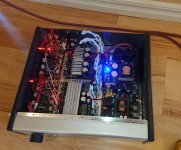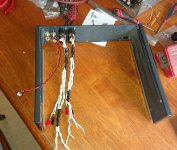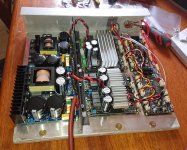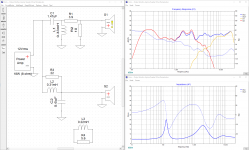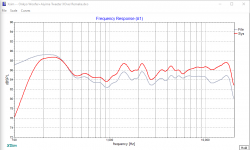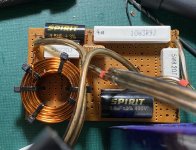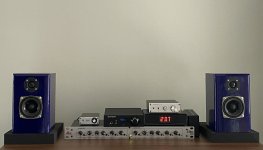Oof, I hope you can get that sorted out. However I'd probably be choosing my own software anyway. REW is capable, if it's something you feel comfortable with.
The reason I asked you the question is because REW needs a stereo input so you can feed the amp signal back into the card.
The reason I asked you the question is because REW needs a stereo input so you can feed the amp signal back into the card.
I'm guessing that the software isn't compatible with the latest version of Windows, but Windows recognize the hardware now and REW seems to work with the "universal" calibration file.
I'll see if I can reach out to them about it, I bought it a couple of years back when it was on sale and I realized that I would need one. But I never bothered connecting it to try it out until now.
But I've improvised a microphone stand (by luck of buying the wrong things before), so I'm ready to make some noise and more importantly measure them. 😀
I'll see if I can reach out to them about it, I bought it a couple of years back when it was on sale and I realized that I would need one. But I never bothered connecting it to try it out until now.
But I've improvised a microphone stand (by luck of buying the wrong things before), so I'm ready to make some noise and more importantly measure them. 😀
Well they didn't give anything useful in return, basically that their software was locked to their more exclusive microphone. 😕
But I got up and measured in REW here, and... something is terribly wrong, and I'm baffled about what it is as the problem seem to move around.
I got Tweeter, Midrange and Woofer measured, did them one and one (On-Axis, 30 degree and Near field, just to try).
Then I hooked up all of them and changed the software in the DSP for 3 channel, and things started to behave strangely.
First of all the sound quality was anything but exciting, so I started tweaking BSC and Level and got it more balanced, better but still bad. But after awhile it got worse, so I did a sweep and it was down by a lot up top, so I realized that the tweeter was the problem.
At this point I could smell something, and it was probably the tweeter. I do use a cap (Jantzen) on the line to protect it, and use a cheap set of speakers to connect to the Amp when I'm unsure about what might happen (strange high pitch noises when programming the DSP sometimes), or I just disconnect the Speak-On.
The thing is that turning off the DSP/Amp will sort of reset the problem, or the sound quality/clarity came back. The level seem to drop only on the channel I've got the cap connected to.
I have tried to eliminate: Cables, drivers, channels on the amplifier, soundcard (source of sound), basically every end of something in my living room have been changed around and triple checked (at least). 😕
The only thing I can replicate is that if I connect one of the cables with cap on any driver the sound level drops, no matter which channel they are connected to, and connecting the tweeter makes it extremely low volume. After that things seem to spiral out of control and DSP/Amp need to be rebooted.
Well, I probably need to order another tweeter, but I have to figure out what it is that sets of this chain of events before I connect it again.
Suggestions? Does your experience or tarot cards tell you something? lol
But I got up and measured in REW here, and... something is terribly wrong, and I'm baffled about what it is as the problem seem to move around.
I got Tweeter, Midrange and Woofer measured, did them one and one (On-Axis, 30 degree and Near field, just to try).
Then I hooked up all of them and changed the software in the DSP for 3 channel, and things started to behave strangely.
First of all the sound quality was anything but exciting, so I started tweaking BSC and Level and got it more balanced, better but still bad. But after awhile it got worse, so I did a sweep and it was down by a lot up top, so I realized that the tweeter was the problem.
At this point I could smell something, and it was probably the tweeter. I do use a cap (Jantzen) on the line to protect it, and use a cheap set of speakers to connect to the Amp when I'm unsure about what might happen (strange high pitch noises when programming the DSP sometimes), or I just disconnect the Speak-On.
The thing is that turning off the DSP/Amp will sort of reset the problem, or the sound quality/clarity came back. The level seem to drop only on the channel I've got the cap connected to.
I have tried to eliminate: Cables, drivers, channels on the amplifier, soundcard (source of sound), basically every end of something in my living room have been changed around and triple checked (at least). 😕
The only thing I can replicate is that if I connect one of the cables with cap on any driver the sound level drops, no matter which channel they are connected to, and connecting the tweeter makes it extremely low volume. After that things seem to spiral out of control and DSP/Amp need to be rebooted.
Well, I probably need to order another tweeter, but I have to figure out what it is that sets of this chain of events before I connect it again.
Suggestions? Does your experience or tarot cards tell you something? lol
I'd like to know your configuration. Some have the processor at the source, some separately and some in the amps. Could you either draw it or describe it?
Here's a photo, I figured I'll tidy up the last bits when it's time to close the lid more permanently. 🙂
It's a 3E DSP/Amp setup, with Connex PSU (in that order left to right on the picture as well).
I took a nap trying to get smarter here, but it didn't help. lol
It's a 3E DSP/Amp setup, with Connex PSU (in that order left to right on the picture as well).
I took a nap trying to get smarter here, but it didn't help. lol
Attachments
From your source to your speakers please, and can you describe the signal ins and outs as well as the physical ins and outs?
I'm sorry if that sounds like a lot. I would do it in a simplified way while staying relevant..it's not easy to communicate that though.
I'm sorry if that sounds like a lot. I would do it in a simplified way while staying relevant..it's not easy to communicate that though.
The source is my PC, usually an upgraded soundcard but for measuring the external soundcard is used. (cable connection)
The RCA in on the box is to the far left on the picture, I use one DSP board for left and one for right channel. So I used the extra input for one added source to select by I/O. (Top RCA to one DSP, bottom to the other)
The DSP is then wired balanced to the amplifiers (2 channel TPA3255, 4 channel TPA3251).
Power is supplied by two Connex PSU (28V/300W + 55V/600W), the amplifiers then supply 12V to the DSP units.
Speaker wires are soldered to Speak-On.
On the outside the wires goes directly from the Speak-On to the drivers, cap for tweeter is in the box 10cm from the driver.
I have tested the system before, but only with two coaxial drivers for cars that I bought cheap for this project as sacrificial, I guess the audio gods wants more. lol
The RCA in on the box is to the far left on the picture, I use one DSP board for left and one for right channel. So I used the extra input for one added source to select by I/O. (Top RCA to one DSP, bottom to the other)
The DSP is then wired balanced to the amplifiers (2 channel TPA3255, 4 channel TPA3251).
Power is supplied by two Connex PSU (28V/300W + 55V/600W), the amplifiers then supply 12V to the DSP units.
Speaker wires are soldered to Speak-On.
On the outside the wires goes directly from the Speak-On to the drivers, cap for tweeter is in the box 10cm from the driver.
I have tested the system before, but only with two coaxial drivers for cars that I bought cheap for this project as sacrificial, I guess the audio gods wants more. lol
Attachments
I'm feeling a problem with the way you've connected this. I'm wondering about DC, where the amps are referenced, connected to the same supplies, is something not connected.
If I were you I'd stop using it and start a fix thread in line level. I'd begin by measuring for offsets at the outputs, including your amps.
If I were you I'd stop using it and start a fix thread in line level. I'd begin by measuring for offsets at the outputs, including your amps.
I'm really scratching my head as well here...
The 'funny' part is that the tweeter got overheated with cap on the line, and the volume (dB) relatively low (though it might have been turned up on the knob).
Something isn't right, the question is if it's the DSP or the 4 channel 3251 amp that's at fault.
But then again, why only when the cap is on the line... 😕
And why does it seem to reset when I power down and up again. I mean, the $20 coaxial drivers sound better than the SB Acoustic then. lol
Yes, I guess I'll try to formulate a thread there instead. 🙂
The 'funny' part is that the tweeter got overheated with cap on the line, and the volume (dB) relatively low (though it might have been turned up on the knob).
Something isn't right, the question is if it's the DSP or the 4 channel 3251 amp that's at fault.
But then again, why only when the cap is on the line... 😕
And why does it seem to reset when I power down and up again. I mean, the $20 coaxial drivers sound better than the SB Acoustic then. lol
Yes, I guess I'll try to formulate a thread there instead. 🙂
It sounds like instability. You wouldn't necessarily see that if you aren't using an oscilloscope.
Sounds very possible, something oscillating outside the auditable range. I think my cats should have reacted, maybe I should upgrade to bat's for future tests. 😛
I sold my oscilloscope, naturally... I had no plans on anything like this then, I used it for cars.
I sold my oscilloscope, naturally... I had no plans on anything like this then, I used it for cars.
I just recalled that the one thing I've changed since my first tests are the RCA in, but it seems farfetched. Well the Speak-On as well, I wired directly to the boards before.
I notice you posted your other thread in digital, do you think this is a digital effect? Line level or higher?
I'll add a link here so people can find it for future reference. 🙂
Could this be a digital line level problem?
I honestly have no idea right now, the amplifier did react to something, as I believe it showed a fault light (but I can't recall when).
I'm used to solving a lot of problems on the go, so even though I'm methodical it can be so much tested in so short amount of time that I forget later what I did. I'm the same way when I work with my computer etc, I recall certain problems and that I solved them, but have no clue how. lol
So, I will start a day soon and go through it slowly. (Got to fix my car first)
I'll make sure to download the programming each time to the DSP and never have my PC connected (that way I can rule out instability in that process).
I'll use an old CD-player I got for audio playback, and PC only for measuring sweep.
I'm going to measure wires one more time, to see that nothing is bad there.
I'll try the generic RCA connection and possibly the Volume control that's on it (came with the DSP, and I strayed away from that design with mine).
I could try and measure output from the amp while playing (to check AC Voltage, if it's high enough to overload the tweeter).
But after that... I have no idea at all. Passive crossover for Tweeter/Midrange and different Amp? I'll guess I'll know in a day or two, but I can't afford any more mistakes. 🙂
Could this be a digital line level problem?
I honestly have no idea right now, the amplifier did react to something, as I believe it showed a fault light (but I can't recall when).
I'm used to solving a lot of problems on the go, so even though I'm methodical it can be so much tested in so short amount of time that I forget later what I did. I'm the same way when I work with my computer etc, I recall certain problems and that I solved them, but have no clue how. lol
So, I will start a day soon and go through it slowly. (Got to fix my car first)
I'll make sure to download the programming each time to the DSP and never have my PC connected (that way I can rule out instability in that process).
I'll use an old CD-player I got for audio playback, and PC only for measuring sweep.
I'm going to measure wires one more time, to see that nothing is bad there.
I'll try the generic RCA connection and possibly the Volume control that's on it (came with the DSP, and I strayed away from that design with mine).
I could try and measure output from the amp while playing (to check AC Voltage, if it's high enough to overload the tweeter).
But after that... I have no idea at all. Passive crossover for Tweeter/Midrange and different Amp? I'll guess I'll know in a day or two, but I can't afford any more mistakes. 🙂
4 would be nice given the (relative to moderan drivers) older design. I love the B139.
f you want to extract the most from these i would suggest one of the TLs Scott and i have done.
A number of versions have been built and people are happy. The boxes on the top row,
Transmission Line Speakers
I like this one best
dave
Hey Dave,
Finally I got round to building this:
http://p10hifi.net/TLS/downloads/PushPush-B139-foldTL-map-300609.pdf
Took me all day today and I fitted the pair of B139's on either side.
Well I was quite disappointed at first.
I was powering it with one AlephJ and the other AlephJ was running the trebles.
This speaker had very low output, way below the treble output so I resorted to powering it with the Monoprice hybrid that has a valve preamp and 50watts a side solid state.
Using that was equally disappointing.
I pulled out half the wadding and things improved by about 100% but still not good enough.
Gave up for the day, it was quite a big day, so tomorrow I pull out all the wadding and retry with the AlephJ. Not optimistic.
Unless there's a serious improvement I'll be continuing on the holy grail search for some proper bass.
Guess it will be time to put the brain in gear and try some designing with GM's theories. I was lazily hoping that this would be pretty good from what you said.
But right now I'm listening to a pair of AMW bookshelfs with a 6" multipurpose driver and a super tweeter and it has a much better overall sound than the above speaker with a pair of 5x4" driver towers by Jensen that can sound pretty good when set right.
So I'm a bit pissed off to be honest. Maybe tomorrow will yield a pleasant surprise.
Cheers.
Your room will have more control over some of the bass than your speaker will. Placement is part of the solution. Some try to overpower the room, not that it's possible but they try to ensure there is an abundance.
However good bass, when affected randomly by the room will be partially over and partially recessed or missing.
However good bass, when affected randomly by the room will be partially over and partially recessed or missing.
I laid the thing on it's side with the port facing upwards and sat it off the floor with a couple of 4x2's.
Actually I should try it with the port facing down. It's a heavy big mother.
I removed most of the wadding. That seemed to improve the efficiency quite a lot.
It's now got a very pleasant thump.
I can feel the sides vibrating so it needs to be stiffened.
I'm wondering whether to simply apply a lot of bracing inside or maybe to lay extra ply on the outside?
I can see how I could place this in the pantry with an outlet for the port and one driver going through the wall.
This is the design criterior for SWMBO so we don't see that damn thing in the living room. Hahaha.
It seems most of the sound comes off the driver though some definitely comes from the port. I would be able to change the alignment of the port so it goes out the same side s one of the drivers and thus through a wall.
The other thing I am concerned about is I am powering each driver from each side of a stereo amp. I wonder how much would be gained by making that signal a solid mono so the push push is totally co-ordinated.
Is it permissable to simply link the speakers at the box terminals to achieve mono or should the stereo inputs be crossed before they get to the amp?
Actually I should try it with the port facing down. It's a heavy big mother.
I removed most of the wadding. That seemed to improve the efficiency quite a lot.
It's now got a very pleasant thump.
I can feel the sides vibrating so it needs to be stiffened.
I'm wondering whether to simply apply a lot of bracing inside or maybe to lay extra ply on the outside?
I can see how I could place this in the pantry with an outlet for the port and one driver going through the wall.
This is the design criterior for SWMBO so we don't see that damn thing in the living room. Hahaha.
It seems most of the sound comes off the driver though some definitely comes from the port. I would be able to change the alignment of the port so it goes out the same side s one of the drivers and thus through a wall.
The other thing I am concerned about is I am powering each driver from each side of a stereo amp. I wonder how much would be gained by making that signal a solid mono so the push push is totally co-ordinated.
Is it permissable to simply link the speakers at the box terminals to achieve mono or should the stereo inputs be crossed before they get to the amp?
Last edited:
Hi Tony and Allen, thank you so very much for all your kind help. I’ve finished the project. I’ve decided to go ahead and built it, and actually have a listen. Boy am I happy I did. It sounds really good, considering the drivers, the size, and my limited knowledge on speaker building. I attach the final schematic as built, the final crossover layout, and the finished pair. I added 5 grams of dacron behind the midwoofer magnet.
Thank you again guys, this thread has been very very educational for me.
Hello again Friends, hope you are all well.
After some months listening to the blue speakers, I feel they are kind of “dark” in their sound. I decided to redo the crossover, running simulations in XSim from scratch. The original crossover design and layout can be found in the quoted post, and the new crossover is attached below. In the frequency response graph, the red graph is the new one, and the gray one is the modeled response of the first crossover. I do feel this reworked crossover takes the build to a new level.
They are actively crossed over at 90Hz to a 12 inch sub.
Attachments
That's the way.
So it seems you've removed some of the baffle step. Normally I'd say this shows that the 'lost' 6dB is actually still in the room and having an influence. It's a frustrating phenomena when you first encounter it.
So it seems you've removed some of the baffle step. Normally I'd say this shows that the 'lost' 6dB is actually still in the room and having an influence. It's a frustrating phenomena when you first encounter it.
Hello,
I have decided to take the diy route for my speakers.
2-ways : ported enclosure and a compression driver & horn on top. x-over with minidsp and bi-amping.
I have been playing a bit with winisd and a 160 liters box with a port. So, either a 15pr400 or 2x12pr320 will get me a nice flat curve.
My question is, is there anything else I should obsess about? I see lots of discussions about baffle diffraction, dampening material, and other minutiae. Do they really matter or a correctly braced birchwood rectangular box with the correct volume and port size is already good enough to have hifi sound?
I have decided to take the diy route for my speakers.
2-ways : ported enclosure and a compression driver & horn on top. x-over with minidsp and bi-amping.
I have been playing a bit with winisd and a 160 liters box with a port. So, either a 15pr400 or 2x12pr320 will get me a nice flat curve.
My question is, is there anything else I should obsess about? I see lots of discussions about baffle diffraction, dampening material, and other minutiae. Do they really matter or a correctly braced birchwood rectangular box with the correct volume and port size is already good enough to have hifi sound?
- Home
- Loudspeakers
- Multi-Way
- Design your own speaker from scratch discussion thread
